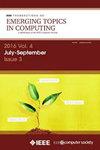DT-Net:带有相邻自适应去噪和基于分裂的上采样变压器的点云补全网络
IF 5.4
2区 计算机科学
Q1 COMPUTER SCIENCE, INFORMATION SYSTEMS
IEEE Transactions on Emerging Topics in Computing
Pub Date : 2025-06-02
DOI:10.1109/TETC.2025.3573505
引用次数: 0
摘要
在3D视觉和机器人技术中,点云补全仍然是一个具有挑战性的问题,它涉及到从部分观测中推断出3D物体的缺失区域。现有的基于学习的框架通常利用编码器-解码器架构,根据从不完整输入中提取的全局形状表示来预测完整点云,或者进一步引入细化网络,以粗到细的方式优化获得的完整点云,无法捕获细粒度的局部几何细节,并且在薄或复杂的结构中充满了噪声点。在本文中,我们提出了一种新的粗到细点云补全框架,称为DT-Net,重点关注粗点云去噪和多级上采样。具体来说,我们提出了一种邻域自适应去噪(NAD)方法来有效地去噪自编码器产生的粗点云,并降低细长结构周围的噪声,使其清晰和良好地表示。此外,还提出了一种新的基于分裂的上采样变压器(SUT),该变压器有效地融合了点云中局部邻域之间的空间和语义关系,用于多级上采样。广泛的定性和定量实验表明,在广泛使用的基准下,我们的方法优于最先进的方法。本文章由计算机程序翻译,如有差异,请以英文原文为准。
DT-Net: Point Cloud Completion Network With Neighboring Adaptive Denoiser and Splitting-Based Upsampling Transformer
Point cloud completion, which involves inferring missing regions of 3D objects from partial observations, remains a challenging problem in 3D vision and robotics. Existing learning-based frameworks typically leverage an encoder-decoder architecture to predict the complete point cloud based on the global shape representation extracted from the incomplete input, or further introduce a refinement network to optimize the obtained complete point cloud in a coarse-to-fine manner, which is unable to capture fine-grained local geometric details and filled with noisy points in the thin or complex structure. In this article, we propose a novel coarse-to-fine point cloud completion framework called DT-Net, by focusing on coarse point cloud denoising and multi-level upsampling. Specifically, we propose a Neighboring Adaptive Denoiser (NAD) to effectively denoise the coarse point cloud generated by an autoencoder, and reduce noise around the slender structures, making them clear and well represented. Moreover, a novel Splitting-based Upsampling Transformer (SUT), which effectively incorporates spatial and semantic relationships between local neighborhoods in the point cloud, is also proposed for multi-level upsampling. Extensive qualitative and quantitative experiments demonstrate that our method outperforms state-of-the-art methods under widely used benchmarks.
求助全文
通过发布文献求助,成功后即可免费获取论文全文。
去求助
来源期刊

IEEE Transactions on Emerging Topics in Computing
Computer Science-Computer Science (miscellaneous)
CiteScore
12.10
自引率
5.10%
发文量
113
期刊介绍:
IEEE Transactions on Emerging Topics in Computing publishes papers on emerging aspects of computer science, computing technology, and computing applications not currently covered by other IEEE Computer Society Transactions. Some examples of emerging topics in computing include: IT for Green, Synthetic and organic computing structures and systems, Advanced analytics, Social/occupational computing, Location-based/client computer systems, Morphic computer design, Electronic game systems, & Health-care IT.
 求助内容:
求助内容: 应助结果提醒方式:
应助结果提醒方式:


